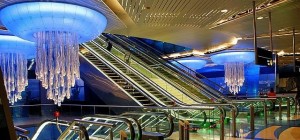By Aya Lowe gulfnews.com
International City and Discovery Gardens continue to bear the burden of steep drops in property values brought on by fresh supply entering the market.
 According to Cluttons, the value of units in the two locations fell by 8.9 per cent in the first three months of the year from the same period in 2010.
According to Cluttons, the value of units in the two locations fell by 8.9 per cent in the first three months of the year from the same period in 2010.
And because of the continuing soft rental market, residents in Dubai have been upgrading to locations such as Jumeirah Lakes Towers and Dubai Marina.
Areas where values have stabilised include well-established communities such as Downtown Dubai and the Emirates Living, which includes the Lakes and Meadows.
According to Cluttons, units in these locations have seen drops of only 3.7 per cent from the end of 2010. “People generally seem to have got ahold of their financial situations post-2008 and confidence is returning in established areas like Emirates Living and Palm Jumeirah, where massive supply is not expected in the future,” said Jonathan Fothergill, dir-ector of UAE valuations at Cluttons. “In addition, mortgages are slowly becoming more available.
“We expect to see further price stabilisation generally for the more sought after lifestyle projects during the remainder of the year and further reductions for less desirable properties.”
Signs of stability
According to Saeed Hashemi, head of valuation and advisory at Landmark Advisory, “Dubai’s prime locations continue to witness signs of stability due to restricted supply and demand remaining buoyant. Demand for apartments in Downtown Dubai remains buoyant, hence values have begun to stablise recently.”
“We are seeing further drops in areas such as International City and Discovery Gardens as there is a lot of competing supply that will be coming online throughout 2011.”
According to a study by the Dubai Chamber of Commerce and Industry, the total supply ratio of villas and apartments in the residential market is 79 per cent apartments and 21 per cent villas. On the supply side, the total residential stock in 2010 came to around 309,301 units and in 2011 is expected to add 25,545 units, according to Jones Lang LaSalle.
This implies that the new supply of residential properties in Dubai is expected to slow down by about 30 per cent compared to 2010.
The year-on-year Dubai residential numbers have declined by 53 per cent and their corresponding transaction values by 65 per cent between the third quarter of 2009 to the fourth quarter of 2010 according to the Dubai Chamber of Commerce and Industry.
The completion of infrastructure projects over the next two years will also help lead the recovery in the real estate sector, the Dubai Chamber of Commerce and Industry report added.
These include the Dubai Metro Green Line and extensions for Dubai International Airport.


















